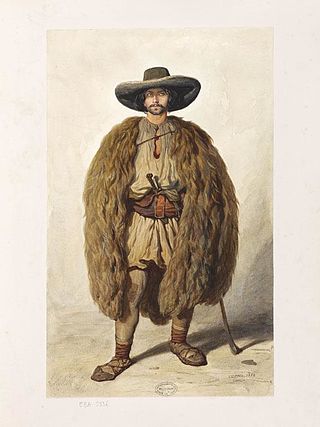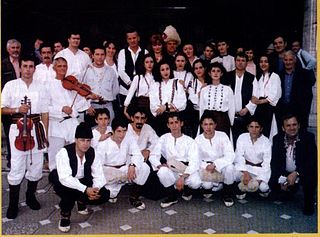Vlachs of Serbia are a Romanian-speaking group in eastern Serbia.
Vlachs of Serbia may also refer to:

Vlach, also Wallachian, is a historical term and exonym used from the Middle Ages until the Modern Era to designate speakers of Eastern Romance languages living in the Balkans and north of the Danube.

The Romanians are a Romance-speaking ethnic group. Sharing a common Romanian culture and ancestry, and speaking the Romanian language, they live primarily in Romania and Moldova. The 2021 Romanian census found that just under 89.3% of Romania's citizens identified themselves as ethnic Romanians.

The Aromanians are an ethnic group native to the southern Balkans who speak Aromanian, an Eastern Romance language. They traditionally live in central and southern Albania, south-western Bulgaria, northern and central Greece and North Macedonia, and can currently be found in central and southern Albania, south-western Bulgaria, south-western and eastern North Macedonia, northern and central Greece, southern Serbia and south-eastern Romania. An Aromanian diaspora living outside these places also exists. The Aromanians are known by several other names, such as "Vlachs" or "Macedo-Romanians".
The Megleno-Romanians, also known as Meglenites, Moglenite Vlachs or simply Vlachs, are an Eastern Romance ethnic group, originally inhabiting seven villages in the Moglena region spanning the Pella and Kilkis regional units of Central Macedonia, Greece, and one village, Huma, across the border in North Macedonia. These people live in an area of approximately 300 km2 in size. Unlike the Aromanians, the other Romance speaking population in the same historic region, the Megleno-Romanians are traditionally sedentary agriculturalists, and not traditionally transhumants. Sometimes, the Megleno-Romanians are referred as "Macedo-Romanians" together with the Aromanians.

The Timok Valley is a geographical region in east Serbia around the Timok River. The Timok Valley corresponds to parts of two Serbian districts, with a total 2022 census population of 200,785.
Knez may refer to:

Romanians are a recognised national minority in Serbia. The total number of self-declared Romanians according to the 2011 census was 29,332, while 35,330 people declared themselves Vlachs; there are differing views among some of the Vlachs over whether they should be regarded as Romanians or as members of a distinctive nationality. Declared Romanians are mostly concentrated in Banat, in Vojvodina, while declared Vlachs are mostly concentrated in the Timok Valley, in eastern Serbia.

The Vlachs are a Romanian-speaking population group living in eastern Serbia, mainly within the Timok Valley. They are characterized by a culture that has preserved archaic and ancient elements in matters such as language or customs. Their ethnic affiliation is highly disputed, with some considering the Vlachs as an independent ethnic group while others consider them part of the Romanians.

The Romanians in Bulgaria, are a Romanian ethnic minority in Bulgaria. In the country, Romanians live in several northern regions, mostly along the Danube. This includes a region between the city of Vidin and the Timok river; these Romanians form a continuous community with the Romanian community in the Timok Valley of Serbia. Another region with a high density of Romanians is located between the towns of Oryahovo and Svishtov. Another goes from Tutrakan to the Bulgaria–Romania border at Northern Dobruja. There also are scattered groups of Romanians within the interior of Bulgaria, such as in Pleven or around Vratsa. The Romanians in Bulgaria are not recognized as a national minority, and they lack minority rights such as schools or churches in their own Romanian language. Many are subject to assimilation.
Anti-Romanian sentiment, also known as Romanophobia is hostility, hatred towards, or prejudice against Romanians as an ethnic, linguistic, religious, or perceived ethnic group, and it can range from personal feelings of hatred to institutionalized, violent persecution.

The Romanian language is widely spoken in Serbia. This country hosts large native Romanian-speaking populations, which can be divided into the ethnic Romanians in the autonomous region of Vojvodina and the Romanian/Vlachs of the Timok Valley, a geographical region in Central Serbia. The former speak the Banat Romanian, identify as Romanians and have full rights within the autonomous region. Romanian is one of the six officially recognized languages of Vojvodina. Romanian/Vlachs speak archaic varieties of the Banat and Oltenian Romanian. Some of the members of community do not identify as Romanians and their language is not recognized as Romanian within Serbia. A "Vlach language" has gone under attempted standardization in the country, using a Cyrillic alphabet. This has been criticized in Romania, and attempts to bring Romanian-language resources and education to the Timok Vlachs have been blocked by the Serbian authorities.
The Aromanians in North Macedonia, also known as the Vlachs, are an officially recognised minority group of North Macedonia numbering some 9,695 people according to the 2002 census. They are concentrated in Kruševo, Štip, Bitola and Skopje.
The term Vlachs was initially used in medieval Croatian and Venetian history for a Romance-speaking pastoralist community, called "Vlachs" and "Morlachs", inhabiting the mountains and lands of the Croatian Kingdom and the Republic of Venice from the early 14th century. By the end of the 15th century they were highly assimilated with the Slavs and lost their language or were at least bilingual, while some communities managed to preserve and continue to speak their language (Istro-Romanians).
The Aromanians in Serbia, most commonly known as "Tsintsars" and sometimes as "Vlachs", are a non-recognized Aromanian ethnic minority in Serbia. Historically, they were an isolated group who focused on preserved their culture, language and identity and on nomadic pastoralism. However, from the second half of the 20th century, the Serbian Aromanians would begin to put aside this practice and migrate to the cities, where they would be subject to assimilation.
Vlach is a historical exonym used to refer to certain groups of speakers of Eastern Romance languages in southeastern Europe.
The Aromanian question, also sometimes known as the "Vlach question", refers to the historical and current division of the ethnic identity of the Aromanians, mostly with ones being pro-Greek, pro-Romanian or self-identified purely or primarily as Aromanian.
The Ullah Millet was a separate millet within the Ottoman Empire. It was established by the Ottoman authorities for the Aromanians in 1905, during the rise of nationalism in the Ottoman Empire. Although the Megleno-Romanians are also sometimes called "Vlachs", the Ullah Millet was not intended for them.
The Aromanians in Bulgaria, commonly known as "Vlachs" and under several other names, are a non-recognized ethnic minority in the country. There are an estimated 2,000 to 3,000 Aromanians in Bulgaria, although estimates coming from Bulgarian Aromanians themselves raise this number to 6,000. They live in the Western Rhodopes, the Blagoevgrad, Pazardzhik, Plovdiv and Sofia provinces and in the city of Sofia, the capital of Bulgaria itself. More precisely, the Aromanians of Bulgaria are concentrated in the villages of Anton and Dorkovo and on the cities and towns of Blagoevgrad, Dupnitsa, Peshtera, Rakitovo, Samokov, Sofia and Velingrad, as well as on parts of the aforementioned provinces located in the Balkan Mountains. Some also live on the towns of Bratsigovo and Pirdop and on the cities of Plovdiv and Pazardjik, as well as on the Rila mountain range.
Vlachs of North Macedonia may refer to:
Vlachs in Bulgaria may refer to: